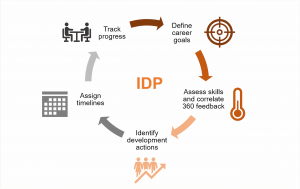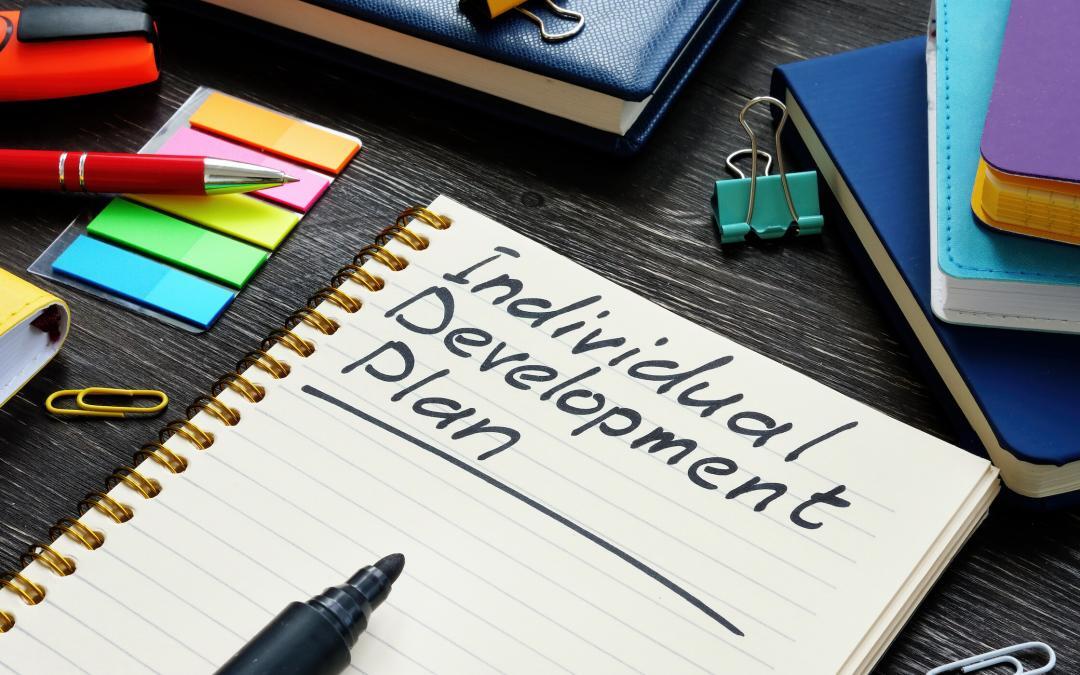Multi-rater Feedback & Individual Development Plans go hand in hand
An Individual Development Plan (IDP) is a tool that assists employees in reaching their short and long-term career goals, and improving their current job performance. It is a planning document that helps carve out the journey. In addition, it shows the commitment between the employee and their manager. Combined with 360 feedback (a well known multi-rater feedback assessment), IDP’s can truly come to life.
360-degree feedback provides a excellent opportunity for employees to understand how they are perceived by their direct reports, superiors, peers, and customers. It motivates the employees and pushes them to improve their skills and performance. Creating an Individual Development Plan by utilizing multi-source feedback is a great way to accelerate performance improvement.
There are many different ways to create an IDP. It can be broken down into the following 5 steps:

1. Define your career goals:
Each employee should take the time to determine their short and long-term career goals. This is a great exercise to go through from time to time, as goals change based on our journey.
In general, a short-term goal is achieved in 6 months to 3 years, while long-term goals can take anywhere from three to 5 years or even longer. In many cases, a long-term goal is achieved with many short-term goals.
Having a reason to improve is key to the success of an Individual Development Plan. Some of the common reasons are:
- To excel in the current role.
- To get promoted to the next level.
- To move to a different job role.
There will likely be no improvement if there is no reason despite having a well-defined plan.
2. Assess the required skills and correlate multi-rater feedback:
Each job role is typically mapped to a set of skills, knowledge and behaviors. Employees who are creating an IDP, must take the time to review the competency requirements of their job role and the Leadership Competency Model of their company. This model will provide a clear picture of what is needed to be succeed in this role.
The next step is to assimilate the feedback received from 360 feedback exercise. Take both the positive points and opportunities for development. Review the feedback and understand the outliers and trends. 360 feedback typically comes with clear explanations. Take the time to review it thoroughly and compare it with the job role’s skills, knowledge and behavior requirements. This will help identify the gaps and get a perspective on the feedback.
3. Identify clear development actions:
This is a crucial step where you will document specific steps that will result in improvement of either knowledge, skills or behavior. Be as specific as possible. Here is an example:
Jane is the Manager of a Service Team in a large organization. She is going through the 360-degree feedback process and is now reviewing the report to create an IDP. Amongst other competencies, she was rated on teamwork. Here is a snapshot of the feedback received:
Team Work: Under Developed (3)
- She tends to go with her ideas and not consider her team’s inputs.
- She can poke holes in a conversation early on, thereby losing support.
- She tends to work alone.
- She contributes to team activities but has difficulty building relationships.
Based on the feedback, Jane needs to work on being a team player in the role of a leader. Most first-time leaders are excellent individual contributors, which is the reason for their role elevation. It takes conscious effort to change the thinking process from an individual contributor to a leader. In Jane’s case, her action item will improve her ability to work with a team. To develop this competency, here are some action items that she can include in her IDP:
- Attend leadership development workshops that promote teamwork and teach brainstorming techniques.
- Schedule periodic team meetings with the team and elicit ideas from the group.
- Create an implementation plan for the best-rated idea and complete a team project.
- Share the learnings and outcomes with her manager.
4. Milestones and responsibilities:
Milestones are clear timelines that provides motivation to succeed. Self-development usually takes a back seat when a business priority arises. Having a solid plan with specific action items that are measurable with timelines and assigned responsibilities will keep the development process on track and allow for easy tracking.
Here is a sample IDP with tasks, timelines and responsibilities:
| Professional Development Goal 1: Improve team work.
Responsibility: Jane |
|||
| Objective | Actions (measurable) | Due Date | Status |
|
|
February 22, 2022 | Enrolled. |
|
March 5, 2022 | Enrolled. | |
|
March 15, 2022 | Not started. | |
|
March 30, 2022 | Not started. | |
|
April 30, 2022 | Not started. | |
| Notes: (Document ongoing notes, progress points, lessons learned)
Month 1 Month 2
|
|||
5. Track progress and set up ongoing coaching conversations:
An IDP is a two-way commitment between the manager and the employee. It is important for both parties to meet periodically, review the action items, and discuss progress. There may be many influences along the way that would lead to adjusting the plan. For example, new business priorities, changes in team structure, modifications to the job role, new team members added to the team, etc. Adjust the plan as needed. The goal is to improve the behavior or skill and continue to keep at it. Skills and behaviors build with time and continuous practice.
In conclusion, an Individual Development Plan, when built with multi-rater feedback, is a great succession planning tool that creates the leadership bench strength in any organization.
Related Resource: 360 feedback: Your Complete Guide
Related Blog Post: 360 Feedback Checklist


 Dr. Jaffee (M.A., Ph.D.) is a recognized expert in the field of assessments, and has created effective HR Solutions used by millions of people.
Dr. Jaffee (M.A., Ph.D.) is a recognized expert in the field of assessments, and has created effective HR Solutions used by millions of people.